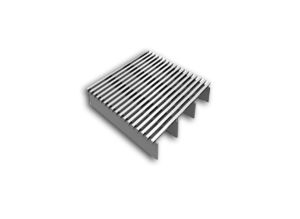
Supers Flat Screens
Supers flat screens can be fabricated with very small wires and rods for critical fine-screening operations, or with much larger wires and rods for heavy-duty operations. The slot size is determined according to the customer’s needs and application. Currently used as: • Filter floors • Support grids • Static grids • Vibrating screens • Floor grates
...more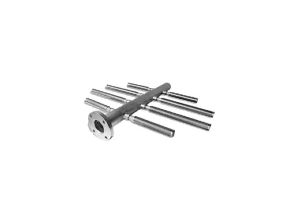
SCREEN LATERAL SYSTEM
These assemblies consist of a series of screen laterals connected to either a central header pipe or a hub. they are designed for effective media retention in a wide range of applications, including ion exchangers, clay and sand filtration applications, and carbon towers. BENEFITS The design allows a uniform collection or distribution flow of a gas or liquid through treatment media without dead zones
...more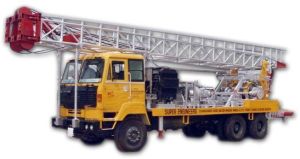
Reverse Rotary Drilling Rigs
RC drilling is similar to air core drilling, in that the drill cuttings are returned to surface inside the rods. The drilling mechanism is a pneumatic reciprocating piston known as a "hammer" driving a tungsten-steel drill bit. RC drilling utilizes much larger rigs and machinery and depths of up to 500 meters are routinely achieved. RC drilling ideally produces dry rock chips, as large air compressors dry the rock out ahead of the advancing drill bit. RC drilling is slower and costlier but achieves better penetration than RAB or air core drilling; it is cheaper than diamond coring and is thus preferred for most mineral exploration work. Reverse circulation is achieved by blowing air down the rods, the differential pressure creating airlift of the water and cuttings up the "inner tube", which is inside each rod. It reaches the "divertor" at the top of the hole, then moves through a sample hose which is attached to the top of the "cyclone". The drill cuttings travel around the inside of the cyclone until they fall through an opening at the bottom and are collected in a sample bag. The most commonly used RC drill bits are 5-8 inches (13–20 cm) in diameter and have round tungsten 'buttons' that protrude from the bit, which are required to drill through shale and abrasive rock. As the buttons wear down, drilling becomes slower and the rod string can potentially become bogged in the hole. This is a problem as trying to recover the rods may take hours and in some cases weeks. The rods and drill bits themselves are very expensive, often resulting in great cost to drilling companies when equipment is lost down the bore hole. Most companies will regularly re-grind the buttons on their drill bits in order to prevent this, and to speed up progress. Usually, when something is lost (breaks off) in the hole, it is not the drill string, but rather from the bit, hammer, or stabilizer to the bottom of the drill string (bit). This is usually caused operator error, over-stressed metal, or adverse drilling conditions causing downhole equipment to get stuck in a part of the hole.
...more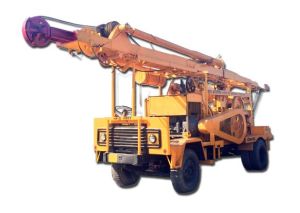
Heavy Percussion Rigs
This drilling is used most frequently in the mineral exploration industry. (This tool is also known as a Down-the-hole drill.) The drill uses a pneumatic reciprocating piston-driven "hammer" to energetically drive a heavy drill bit into the rock. The drill bit is hollow, solid steel and has ~20 mm thick tungsten rods protruding from the steel matrix as "buttons". The tungsten buttons are the cutting face of the bit. The cuttings are blown up the outside of the rods and collected at surface. Air or a combination of air and foam lift the cuttings. RAB drilling is used primarily for mineral exploration, water bore drilling and blast-hole drilling in mines, as well as for other applications such as engineering, etc. RAB produces lower quality samples because the cuttings are blown up the outside of the rods and can be contaminated from contact with other rocks. RAB drilling at extreme depth, if it encounters water, may rapidly clog the outside of the hole with debris, precluding removal of drill cuttings from the hole. This can be counteracted, however, with the use of "stabilizers" also known as "reamers", which are large cylindrical pieces of steel attached to the drill string, and made to perfectly fit the size of the hole being drilled. These have sets of rollers on the side, usually with tungsten buttons, that constantly break down cuttings being pushed upwards. The use of high-powered air compressors, which push 900-1150 cfm of air at 300-350 psi down the hole also ensures drilling of a deeper hole up to ~1250 m due to higher air pressure which pushes all rock cuttings and any water to the surface. This, of course, is all dependent on the density and weight of the rock being drilled, and on how worn the drill bit is.
...more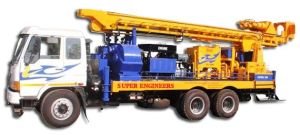
Dth Drilling Rigs
A Down-The-Hole Drill is called DTH in most drilling terms. The down-the-hole drill is basically a mini jack hammer that screws on the bottom of a drill string. The fast hammer action breaks hard rock into small flakes and dust and is blown clear by the air exhaust from the DTH hammer. The DTH hammer is one of the fastest ways to drill hard rock. Now smaller portable drillcat drilling rigs with DTH hammers can drill as fast as much larger truck rigs with this newer technology. In DTH drilling, the percussion mechanism – commonly called the hammer – is located directly behind the drill bit. The drill pipes transmit the necessary feed force and rotation to hammer and bit plus compressed air or fluids for the hammer and flushing of cuttings. The drill pipes are added to the drill string successively behind the hammer as the hole gets deeper. The piston strikes the impact surface of the bit directly, while the hammer casing gives straight and stable guidance of the drill bit. This means that the impact energy does not have to pass through any joints at all. The impact energy therefore is not lost in joints allowing for much deeper percussion drilling. This is a Great break through for smaller portable water well drilling rigs, that before were limited. The DTH on smaller rigs now can get same results as large heavy truck rigs. `
...more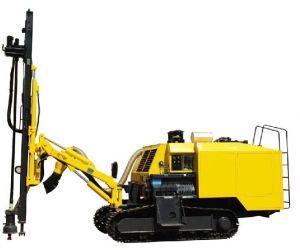
Dth Drilling Rig
A Down-The-Hole Drill is called DTH in most drilling terms. The down-the-hole drill is basically a mini jack hammer that screws on the bottom of a drill string. The fast hammer action breaks hard rock into small flakes and dust and is blown clear by the air exhaust from the DTH hammer. The DTH hammer is one of the fastest ways to drill hard rock. Now smaller portable drillcat drilling rigs with DTH hammers can drill as fast as much larger truck rigs with this newer technology. In DTH drilling, the percussion mechanism – commonly called the hammer – is located directly behind the drill bit. The drill pipes transmit the necessary feed force and rotation to hammer and bit plus compressed air or fluids for the hammer and flushing of cuttings. The drill pipes are added to the drill string successively behind the hammer as the hole gets deeper. The piston strikes the impact surface of the bit directly, while the hammer casing gives straight and stable guidance of the drill bit. This means that the impact energy does not have to pass through any joints at all. The impact energy therefore is not lost in joints allowing for much deeper percussion drilling. This is a Great break through for smaller portable water well drilling rigs, that before were limited. The DTH on smaller rigs now can get same results as large heavy truck rigs. `
...more
Direct Rotary Drilling Rig
Direct push technology includes several types of drilling rigs and drilling equipment, which advances a drill string by pushing or hammering without rotating the drill string. While this does not meet the proper definition of drilling, it does achieve the same result — a borehole. Direct push rigs include both cone penetration testing (CPT) rigs and direct push sampling rigs such as a Power Probe Direct push rigs typically are limited to drilling in unconsolidated soil materials and very soft rock. CPT rigs advance specialized testing equipment (such as electronic cones), and soil samplers using large hydraulic rams. Most CPT rigs are heavily ballasted (20 metric tons is typical) as a counter force against the pushing force of the hydraulic rams which are often rated up to 20 kN. Alternatively, small, light CPT rigs and offshore CPT rigs will use anchors such as screwed-in ground anchors to create the reactive force. In ideal conditions, CPT rigs can achieve production rates of up to 250–300 meters per day. Direct push drilling rigs use hydraulic cylinders and a hydraulic hammer in advancing a hollow core sampler to gather soil and groundwater samples. The speed and depth of penetration is largely dependent on the soil type, the size of the sampler, and the weight and power of the rig. Direct push techniques are generally limited to shallow soil sample recovery in unconsolidated soil materials. The advantage of direct push technology is that in the right soil type it can produce a large number of high quality samples quickly and cheaply, generally from 50 to 75 meters per day. Rather than hammering, direct push can also be combined with sonic (vibratory) methods to increase drill efficiency.
...more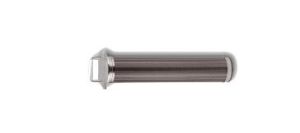
Cylinder Screen
Our customers can avail from us an excellent quality range of V Wire Wrapped Super Screen Cylinders with following features: Materials: 304, 302, 304L, 316, 316L stainless steel wire Or low carbon galvanized steel. The wire is wedge shaped. The rods could be round or triangular. O.D:1 INCH-40 INCH Styles of connection: by welding or by threaded male/female coupling. Standard length : 3m/5.85m The slot : 0.1mm-30mm
...more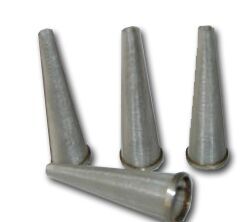
Cone v wire Screen
This type of wire mesh filter screen is mainly applied in chemical, pharmaceutical, and beverage industries. Due to the feature of cone-shape, it can make the media get the better diversion, separation and filtration. Material: 304, 304L, 316, 316L stainless steel. Features: 1) Cone –shaped filter screens as per customer's requirements 2) Widest possible range in microns
...more
Cage V Wire Wound Screen
Super Screens are more suitable for the construction of high-quality water wells, oil wells and gas wells because of high open area. 2. Low cost operation: Screens with high open area shall favour groundwater in Filtration. Abundant water shall reduce the drawdown inside the well, thus reducing energy demand on the pump. 3. Reduce the abrasion of the pump: Under the same condition,
...more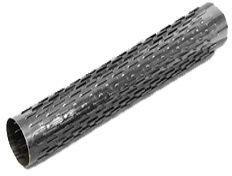
Bridge Slots
We are one-step ahead of our competitors in manufacturing and supplying a qualitative range of Industrial Bridge Slots. These are precisely engineered using high quality components sourced from reliable vendors of industry. Some of the key features which make these devices one of the preferred choices of clients are durability, precision engineering, accurate dimensions, rugged construction and high functionality. These devices are reasonably priced
...moreBe first to Rate
Rate ThisOpening Hours